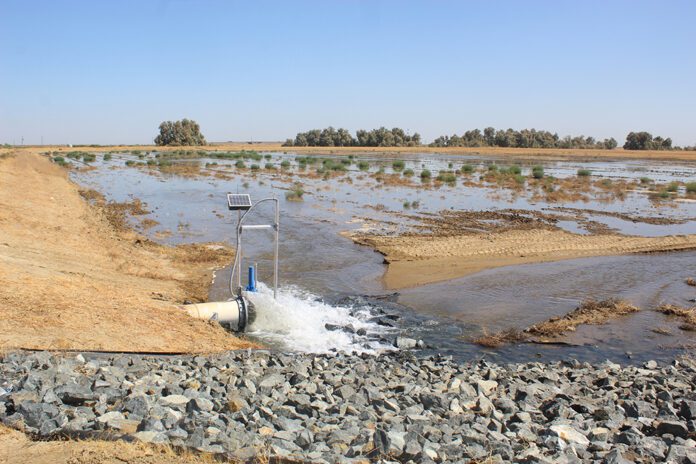
The first phase of a long-term project by Westlands Water District to double its groundwater recharge capacity and secure a sustainable water supply within the Valley’s largest irrigation district reached completion in late August. The milestone was celebrated on the final day of testing on the Pasajero Groundwater Recharge Basin, where approximately 420 acre-feet of water was recharged into a percolation basin.
Adjacent to Interstate 5 in Coalinga, Calif., the Pasajero basin includes a new 30-cubic-feet-per-second conveyance turnout from the Coalinga Canal and six basins. Phase one can recharge up to 21,000 acre-feet of water annually, while phase two will add up to 10 dry wells, enhancing the recharge capacity by an additional 5,000 acre-feet, allowing surface water to be conveyed directly into the aquifer. The district last year was able to recharge nearly 400,000 acre-feet of water and is hoping to nearly double that capacity, up to 800,000 acre-feet.
Roughly the size of Rhode Island, Westlands Water District serves the western side of Fresno and Kings Counties and is the largest agricultural water district by irrigatable acres in the United States. Allison Febbo, general manager for the district, said the success of the project was dependent on the collaboration of many entities working together to protect agriculture
“I think we’ve recognized we all have to work together now and that agriculture in the Central Valley is important for the state, and not just the state, our nation and global food supply,” Febbo said. “We are completely reliant on our surface water supply; it’s our lifeblood, and we have to have that to be able to continue farming here.”
She noted that other partnerships with the district have included signed memorandums of understating with Friant Water Authority, Metropolitan Water District, and Valley Water District.
Febbo said the decline in water supply reliability over the decades due to climate change and environmental issues has created “water wars” that have led to fierce competition for resources. To address it, she emphasized the importance of the district taking control by capturing excess water during wet years and storing it in recharge basins for use during dry periods to support growers.
“We had two 0% allocation years, and that almost decimated not just our growers, but the communities in our area,” she said. “So, this is taking control of our own destiny, taking that excess water when it’s flooding and there’s too much throughout the state and being able to recharge it here so that it’s there in the future.”
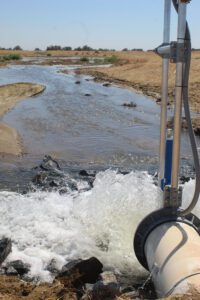
Westside Subbasin GSP
As agencies establish groundwater sustainability plans (GSP) to comply with the State Groundwater Management Act, Febbo said the basin project fits into their Westside Subbasin GSP.
“Now, with the Sustainable Groundwater [Management] Act, we’ve learned we have to recharge those basins when it’s a wet year so water can be there and available in those dry years. We don’t want to continue overdrafting,” she said.
John Watts, Bureau of Reclamation senior counselor to the commission, said Westlands’ success of gaining close to 400,000 acre-feet of groundwater recharge in 2023 was a feat to be acknowledged.
“When we hear in the news about all this excessive groundwater pumping and land subsiding, what Westlands did in 2023 was they got uplift,” he said. “The ground rose over 380,000 acre-feet of recharge, that’s a real accomplishment.”
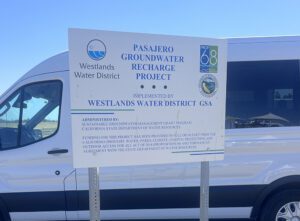
Watts said we need to retool our infrastructure as well as our thinking, which he said the Pasajero project does by focusing on upgrading infrastructure and developing groundwater recharge systems, which are vital in adapting to climate change. He noted the region has already experienced extreme weather patterns such as the significant floods in late 2022 followed by a severe drought just months later, so it underscores the urgent need for improved water management.
“When we have these crazy storms with water washing away to the Delta, we need to find a way to capture and store it somewhere for the droughts, and that’s what this project and the others like it are doing,” he said. “We can capture these flows so when the droughts come, we have some more water.”
Stressing the need for innovation, Karla Nemeth, director of California Department of Water Resources, said Westlands wrote the book on it.
“It’s not at all surprising you all would be the early adopters of these new ideas to make sure we can sustain ourselves and create a water resilient future for growers of Westlands and communities in Westlands,” she said.
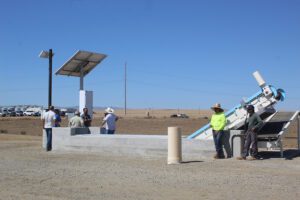
Implementation and Management
The logistics of launching a project of this magnitude required the involvement of irrigation companies to install specialized equipment. Eric Rothberg, sales manager for Rubicon Water, said his company specializes in canal automation, producing gates and other irrigation products critical for such projects at its Modesto, Calif. location just two hours north.
“There’s a huge market for automation of canals like you have in the valley, maintaining them full, avoiding spills, measuring the water, so that’s the big thing we do, we provide a very precise accounting of the water distribution,” he said.
For the Pasajero project, Rothberg said the focus wasn’t on measuring water but on providing essential equipment designed for releasing flow, while the valves they provided are solar-powered and communicate via radio, making them ideal for remote locations like this one, where electric power isn’t readily available.
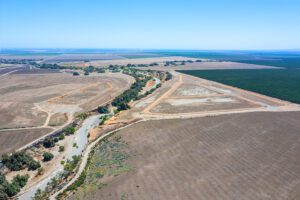
“Because of that, you don’t have to actually come here to open the gate, you can do it from anywhere,” Rothberg said.
The week-long testing process leading up to the ribbon cutting ceremony ensured the pipes were working and that everything was graded correctly. Noting the landscape’s thirsty soil, Febbo said it was a testament to the project’s success that water wasn’t building up in the basins during the testing process.
“That’s what you want to see to prevent evaporated loss and other issues,” she said. “I believe we’ve seen success here. Just seeing the percolation rate is also a huge success.”
The entire project sits on just 29 acres of land, Febbo noted.
“It’s a very small footprint for such a substantial amount of recharge,” she said. “So, when we can use these as examples and build out, and we can get upwards of 800,000 acre-feet or a million acre-feet, that’s what makes this so exciting.”
Funding for the project included nearly $4 million from California Department of Water Resources’ Sustainable Groundwater Management Proposition 68 Implementation Grant Program, along with over $2.6 million from the district. Additionally, Westlands recently received $25 million through the federal Inflation Reduction Act to support similar recharge projects, which will further enhance collaborative drought resiliency efforts.
Phase two of the project will begin with the construction of the dry wells in the first half of 2027.
Going forward, Febbo said the project will be able to sustain agriculture into the future for the district, which she reiterated is first and foremost an agricultural water district.
“We know our farms support a lot of communities in this area that are underserved, so we’re hoping with this and further recharge projects, that our agriculture is sustained into the future and that our communities are sustained into the future,” she said.

Kristin Platts | Digital Content Editor and Social Correspondence
Kristin Platts is a multimedia journalist and digital content writer with a B.A. in Creative Media from California State University, Stanislaus. She produces stories on California agriculture through video, podcasts, and digital articles, and provides in-depth reporting on tree nuts, pest management, and crop production for West Coast Nut magazine. Based in Modesto, California, Kristin is passionate about sharing field-driven insights and connecting growers with trusted information.















